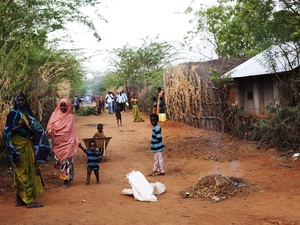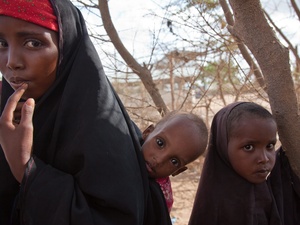Somali exodus slows in Horn of Africa but grows in Yemen
Somali exodus slows in Horn of Africa but grows in Yemen
With the crisis in the Horn of Africa continuing, UNHCR has noted an evolving displacement pattern during August with fewer Somalis displaced within Somalia or into Kenya or Ethiopia, but rising arrivals in Yemen.
In Somalia, UNHCR's Population Movement Tracking (PMT) partners have reported a significant drop in the numbers of people arriving in Mogadishu. It appears that the influx of internally displaced people (IDPs) into Mogadishu peaked in July, when nearly 28,000 fled to the Somali capital in search of humanitarian help. However, since the beginning of this month, just over 5,000 displacements into the city have been recorded. The average daily arrival rate in the city dropped from more than 1,000 per day last month to an estimated 200 in August.
Almost no movements or returns were recorded in districts of Mogadishu previously under Al Shabaab control, mainly due to insecurity - now in the form of guerrilla warfare. Several protection issues, including looting in these districts have also been reported. Furthermore, there are no livelihood opportunities and most of these areas were destroyed by previous fighting. AMISOM has also imposed restrictions on civilian movement or return to previously Al Shabaab-controlled areas while security operations are conducted.
We are also seeing reports of Al Shabaab continuing to place restrictions on movement in areas under its control, particularly movements of men - most notably in the Lower Shabelle and Bay regions in the wake of the Al Shabaab withdrawal from the capital on August 6. This has prevented large population movements, especially from Lower Shabelle, into Mogadishu.
IDPs interviewed by our PMT partners also indicate that donations from the Somali diaspora and mobilization by local and host communities in July and August to assist the affected populations during the holy month of Ramadan may have enabled people to remain where they were.
Furthermore, international and local organizations, including UNHCR, have been better placed to deliver aid to famine-affected populations in Bay, Gedo, south Bakool and Hiraan regions, particularly in areas along the Kenya and Ethiopia borders. This has helped to reduce the pressure on Mogadishu as a destination to seek aid. UNHCR this week completed the distribution of 3,000 Emergency Assistance Packages (EAPs) for up to 18,000 people in the Hiraan region, which is under Al Shabaab control.
Kenya, with nearly 498,000 Somali refugees, remains the largest host country. Recently, however, the pace of arrivals to the Dadaab refugee complex has slowed to 1,000-1,200 people per day, from 1,500 previously. At the same time, our staff on the ground say the overall health state of the latest arrivals, particularly the children, is worse than previously - reflecting the drought and hunger situations inside Somalia. In interviews with our staff, some of the new arrivals say they came from Al Shabaab areas of Gedo and Lower Juba, where insecurity had seriously hampered aid delivery.
The relocation operation for recent arrivals who had been encamped on the outskirts of Dadaab's camps has now transferred nearly 27,000 Somalis into family tents at the Ifo Extension and Kambioos sites.
In Ethiopia's Dollo Ado camps, we remain concerned about the extremely poor health of recent arrivals from Somalia. Since early August, some 290 cases of suspected measles and 18 related deaths have been reported. Vaccination continues to be underway in the area's four refugee camps targeting all children between the ages of six months and 15 years.
At the same time, UNHCR and our partners are continuing to step up health services in the camps. Four satellite clinics have been established. We plan to further decentralize services so that refugees can access medical care more easily. Facilities are now open on a 24-hour basis at MSF's clinics in the new Hilaweyn camp. Construction is starting on Dollo Ado's second stabilization centre for acutely malnourished children in Kobe camp. Clean delivery kits have also been distributed in camps to reduce the risk of maternal mortality.
Bucking the trend of the slowing outflow in the Horn of Africa, Yemen is seeing a sharp rise in the number of Somali refugees arriving on rickety boats across the Gulf of Aden. More than 3,700 Somali refugees have reached Yemen's coast so far in August. This marks an earlier than normal start to the traditional peak season for smugglers' boats to arrive from Bossaso in northern Somalia, and is the highest monthly arrival rate so far this year. The new arrivals tell our staff they fled Somalia because of the unstable security situation, severe drought, high food prices and lack of job opportunities.
It is testament to the refugees' desperation that they have chosen to flee to Yemen, which is itself affected by serious unrest. They cross the Gulf of Aden on what are often unseaworthy and overcrowded boats. Many do not survive the dangerous crossing. On Monday, two Somalis drowned when their boat capsized. Nonetheless, more Somalis are expected to arrive in Yemen in the coming months. We believe many who fled their homes are already waiting in Bossaso for calmer seas before starting their journey. Yemen hosts the second-largest population of Somali refugees in the region, with nearly 192,000. Some 15,000 of them have arrived since January.
Learn more about the crisis in the Horn of Africa and how to contribute by visiting the UNHCR Horn of Africa emergency donation site. For the latest updates follow us on Facebook or Twitter.
For further information on this topic, please contact:
- In Nairobi UNHCR regional office: Ron Redmond on mobile +254 734 564 019
- In Nairobi UNHCR Kenya office: Emmanuel Nyabera on mobile: +254 773 995 975
- In Kenya, UNHCR Somalia Office: Andy Needham on mobile +254 733 120 931
- In Ethiopia: Kisut Gebre Egziabher on mobile +251 911 208 901
- Laura Padoan on tel: +252 618389306












